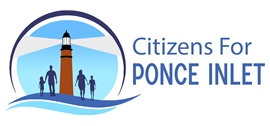MARINE SCIENCE CENTER
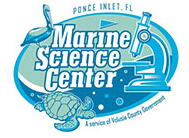
Marine Science Center is back!
Locals and tourists can rediscover the wonders of the Marine Science Center in Ponce Inlet, which has resumed public hours from 10 a.m. to 5 p.m. Tuesday through Saturday and noon to 5 p.m. Sunday.
The center was closed to visitors throughout much of the COVID-19 pandemic, but employees continued to care for sick and injured sea turtles and birds. In fact, staff is rehabilitating a record number of baby birds, including screech owls, red-shouldered hawks and sandhill cranes.
Today, the Marine Science Center is looking after 76 birds and 27 sea turtles. Visitors can watch as the turtles receive specialized care from a University of Florida veterinarian and trained wildlife rehabilitation staff.
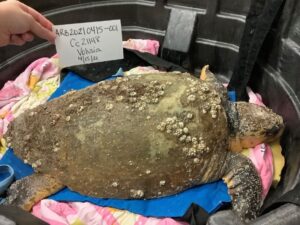
One of the more conspicuous residents is a 240-pound loggerhead named Sunrise, who stranded in Daytona Beach on April 15. After arriving underweight and covered with barnacles and leeches, she has been treated with fluid therapy, antibiotics and supplements. She received IV nutrition and is now eating one her own.
In addition to visiting the turtle and bird hospitals, visitors can view bald eagles and wading birds, walk along the nature trail and learn about marine life in the center’s exhibit hall, which includes a touch pool, artificial reef aquarium, living reef, moray eel exhibit and gift shop.
Since opening in 2002, the Marine Science Center has cared for more than 25,000 sea turtles, gopher tortoises, freshwater turtles and snakes. The adjacent Mary Keller Seabird Rehabilitation Sanctuary has received more than 18,000 birds since it opened in 2004.
Sea turtle nesting season started May 1
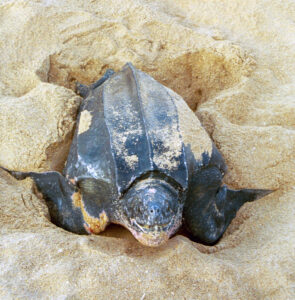
Turtle nesting season officially started May 1, which means hundreds of sea turtles will be emerging from the surf to lay eggs on the beach in the next few months.
After incubating in the sand for about two months, tiny hatchlings will break free and make an often treacherous crawl to the ocean, dodging predators, holes, trash and beach furniture. Tragically, some will also be led into harm’s way by beachfront lighting.
It’s estimated that only about one in 1,000 to 10,000 hatchlings will make it safely to sexual maturity, which may take 10 to 25 years.
Ryan Chabot, Volusia County’s sea turtle Habitat Conservation Plan program manager, wants to improve those odds, and he could use the public’s help.
“We want to make Volusia County beaches safe, inviting places for humans and sea turtles,” he said. “We encourage residents and visitors alike to respect our wildlife; let the night provide the light; and keep our beaches clean, dark and flat.”
“Artificial lighting is a human-made threat we can correct with minimal effort,” he added. “Bright lights can discourage adult female sea turtles from nesting and confuse hatchlings, leading them away from the ocean and into streets or storm drains. By simply redirecting lights away from the beach and turning them off when not in use, beachfront residents can allow natural moonlight and starlight to guide nesting females and hatchlings and keep them out of danger.”
The county’s Environmental Management Division works with beachfront property owners throughout the year, educating them about the sea turtle lighting ordinance. During the nesting season, residents are required to, shield, redirect or turn off lights so they don’t shine on the beach.
Residents and visitors can also help save sea turtle lives by following these tips on the beach:
- Do not touch or disturb sea turtles or their nests. It’s important that hatchlings make their own way to the ocean.
- Do not disturb the dune system or plants. Use designated beach access points and do not walk on the dunes.
- When driving at the beach, use the designated traffic lanes and parking areas. Beach driving access hours are from 8 a.m. to 7 p.m. throughout the nesting season, tide permitting.
- Do not use flash photography at night.
- Do not use cellphones to light your way at night.
- Use only red LED flashlights; they are less visible to turtle eyes.
- After a day at the beach, flatten sandcastles, fill in holes, and take your chairs and equipment with you. This is an easy way to reduce obstacles faced by sea turtles.
- Dispose of trash and recyclables in proper receptacles. Trash left on the beach can attract predators that impact sea turtle nests.
- Do not use fireworks. They are not only prohibited on the beach at all times, but they can be disruptive to turtles.
- If you see a nesting adult sea turtle or hatchlings making their way to the ocean, admire them from a safe distance. Stand far away, remain calm and quietly enjoy this special experience.
- If a turtle appears to be in immediate danger, notify a lifeguard or Beach Safety officer or call the Florida Fish and Wildlife Conservation Commission at 888-404-3922.
Nesting season runs through Oct. 31. During a typical year, 400 to 500 nests are laid in Volusia County. Last year’s season was the third highest nesting season on record, with 902 nests counted.
For more information about Volusia County’s sea turtle program, call 386-238-4668 or visit www.volusiaseaturtles.org.
For questions about sea turtle-friendly lighting, call 386-238-4773.
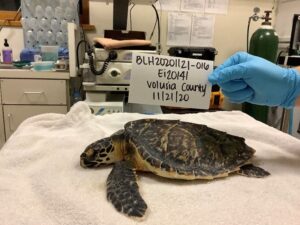
2021 is proving to be a record-breaking year for our rehabilitation hospitals. The number of patients treated in both hospitals continues to exceed all expectations. We have treated over 171 Sea Turtles, which is quickly approaching our record year of 171 patients back in 2010.
One patient that is worth taking note of is Timon, a beautiful juvenile Hawksbill Sea Turtle. Timon is a rare species of turtle to strand in our Volusia County area. Typically, Hawksbill Sea Turtles can be found farther down south. Timon was stranded in New Smyrna Beach in November 2020. Upon intake, Timon was found to have foreign material ingested. Timon has been receiving fluid therapy, antibiotics and was tube fed for several months but is now eating on its own. We are hopeful Timon will make a full recovery soon.
Our Mary Keller Seabird Rehabilitation Sanctuary has been equally busy treating over 624 sick and injured birds. The Seabird Sanctuary is treating 76 in the hospital at this time many of which are baby birds. Several interesting baby bird species treated this year are Eastern Screech Owls, Bald Eagles, Osprey, and many songbirds.
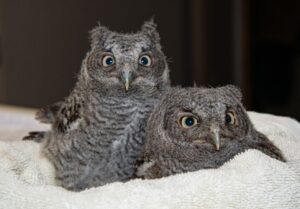
With the tireless dedication of our community support, from volunteering to donations, your help is essential to provide the quality animal care our community needs.
To learn more about how you can help, please visit our Marine Science Center website www.marinesciencecenter.com or follow us on our social media outlets;
Instagram @marinesciencecenter
Facebook @friendsofthemarinesciencecenter
Work done under permits: MTP194, WLR-0081 and MB795949-0.
TABLE OF CONTENTS
Page 1 – Town of Ponce Inlet, Citizens for Ponce Inlet (CFPI)
Page 2 – Candidates Forum, Ponce Inlet Election 2021
Page 3 – Meet the Candidates – Seat 1 (Mayor) – Tony Goudie
Page 4 – Meet the Candidates – Seat 1 (Mayor) – Lois Paritsky
Page 5 – Meet the Candidates – Seat 3 – Elizabeth Caswell
Page 6 – Meet the Candidates – Seat 3 – David Loh
Page 7 – Meet the Candidates – Seat 5 – Gary Smith
Page 8 – Garden Club of Ponce Inlet
Page 9 – Ponce Animal Welfare (PAW), Women’s Club
Page 10 – Ponce Inlet Lions Club
Page 11 – PICCI, PI Lighthouse Assoc., PI Veterans Memorial Assoc.
Page 12 – Marine Science Center
Page 13 – Ponce Church
